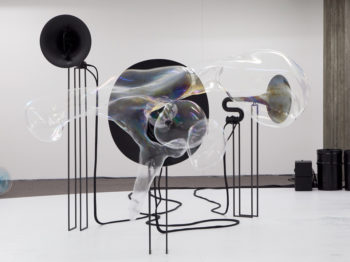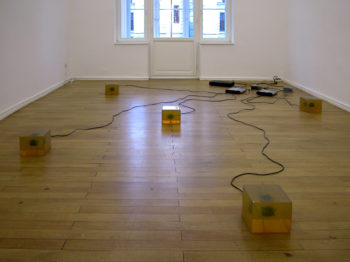
Thom Kubli
2019-20 Ida Ely Rubin Artists in Residence
Exploring the boundaries of physical space and floating structures
About the Residency
Multidisciplinary artist and composer Thom Kubli is collaborating with Jerome B. Wiesner Professor of Media Arts and Sciences Hiroshi Ishii and members of the Tangible Media Group at the MIT Media Lab to develop a 3D printer capable of creating ultra-light hollow shapes filled with helium. The sculptures released from the machine ascend to the upper realm of space, where they are caught in a thermal stream and eventually float in an orbital movement.
Kubli and Ishii are working with researchers in Materials Science and Engineering as well as faculty in Architecture to determine the necessary properties for a lighter-than-air printing material and investigate construction algorithms for 3D-printed objects that take into account particular material properties in relation to an embedded helium core.
Kubli envisions the sculptures as artistic references to other objects that have had cultural impact in the pantheon of modernity, such as spacecraft and smartphones. The sculptures will circulate for an unlimited period of time in zero gravity, as a new form of space debris that evokes the encyclopedic collections of objects found in Wunderkammern, the cabinets of curiosities of the European Renaissance.
The prototypes developed at MIT will be used in an installation intended to transform the original significance and material culture of objects and create an alternate metaphysical reality. The artist seeks to deprive objects of their weight, both conceptually and practically, and have them join a future transcendent vortex.
This artist residency is supported by the Ida Ely Rubin Artists in Residence Fund.
Schedule
Residency Visits
Material
Spring 2019
Architecture
Fall 2019
Design
Spring 2020
Collaborators at MIT
Hiroshi Ishii, Jerome B. Wiesner Professor of Media Arts and Sciences and Associate Director, Media Lab, MIT
Krysten Van Vliet, Associate Provost and Michael (1949) and Sonja Koerner Professor of Materials Science and Engineering, MIT
Skylar Tibbits, Assistant Professor of Architecture and Founder and Co-Director of the Self-Assembly Lab, MIT
Michael Tarkanian, Senior Lecturer, Department of Materials Science and Engineering, MIT
Kyung Yun Choi, Research Assistant, Tangible Media Group, Media Lab, MIT
Hila Mor, Research Assistant, Tangible Media Group, Media Lab, MIT
Benjamin Miller, Graduate Student, Department of Mechanical Engineering, MIT
Bill McKenna, Lab Assistant, Synoptic and Fluid Labs, Department of Earth, Atmospheric and Planetary Sciences, MIT
Joshua Van Zak, Research Assistant, Mediated Matter, Media Lab, MIT
Valentina Sumini, Postdoctoral Associate, Responsive Environments, Media Lab, MIT
Joao Wilbert, Research Assistant, Tangible Media Group, Media Lab, MIT
Biography
Thom Kubli draws inspiration from the fields of musical composition, sculpture, architecture, natural science, and new technologies. His poetic explorations of material, sound and technology investigate critical dispositions in global social and political processes. Kubli’s installations and performances are multidisciplinary, blending elements of bioengineering, materials science, and artificial intelligence with the invention of kinetic machines and sonic environments.
In his early works, Kubli created sound sculptures by means of collagen, genetically modified plants and other organic matter. In 2008, he achieved the world record for the longest guitar solo ever played during an art performance. Engaging with the theme of zero gravity, Kubli’s installation FLOAT! Thinktank 21 (2010) aimed to explore the political dimensions of weightlessness using historical NASA technology in the form of a sensory deprivation tank. Black Hole Horizon (2012–16) delved into the architectural and sculptural potential of soap bubbles, resulting in an array of machines that transform sound into 3D objects. In a recent installation, he investigated the manipulation of media information by means of artificial intelligence.
Kubli’s artwork has been exhibited at the New Museum in New York City, Eyebeam, EMPAC, Marian Spore NYC, Laboratorio Arte Alameda in Mexico City, LABoral, MARCO, Akademie der Künste in Berlin, Transmediale in Berlin, Ars Electronica in Linz, FILE-Festival in São Paulo, and The Lowry in Manchester. His composition pieces and experimental radio plays have been widely broadcast through European Public Radio stations.
More on the artist’s website: Thom Kubli
In the Media
“It was important to me for the sound to have a material correspondence, not a virtual one… translating sound into physical material—for instance, into biomass, a liquid or granulate.”
— Thom Kubli
Wired: Artists Fight Gravity In Dancing On The Ceiling
Ars Electronica: Black Hole Horizon: Sounds into Soap Bubbles
Sky Arte: Orbiting, la nuova installazione fluttuante sulla storia dell’umanità




